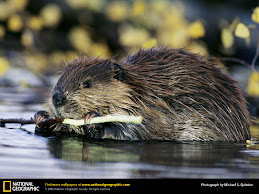 On a walk this morning searching for two of my favorite signs of spring, I was immersed in flowers spouting and birds signing. But I was oh-for-two. Dang.
On a walk this morning searching for two of my favorite signs of spring, I was immersed in flowers spouting and birds signing. But I was oh-for-two. Dang.I was sauntering through Saunders Woods, a nature preserve managed by the Natural Lands Trust, looking to see where in spring’s parade we stand. And I wanted desperately to find two classic signs of spring, trillium (left), a classic wildflower, and warblers, the classic birds of spring.
Spring is an elegant procession of delirious natural acts: songbirds migrating through, wildflowers blossoming in sequence, frogs and salamanders mating in vernal pools. For me, the parade begins in February when skunk cabbage blooms in cold marshy areas, its purple hood heating and melting any ice in its way.
So today I’m standing in a carpet of lesser celandine, a beautiful but entirely alien flower that takes over forests and fields. But I’m also seeing early May apples poking their small umbrella-shaped leaves th
 rough the celandine. Trout lilies (right), a classic spring wildflower, have sent up trout-speckled leaves across the forest floor—after many years of patiently storing starches in its root, trout lilies have enough energy to finally make a flower. Happily, in a far corner of the preserve is a stand of trout lilies that have flowered, bright yellow flags in the processional.
rough the celandine. Trout lilies (right), a classic spring wildflower, have sent up trout-speckled leaves across the forest floor—after many years of patiently storing starches in its root, trout lilies have enough energy to finally make a flower. Happily, in a far corner of the preserve is a stand of trout lilies that have flowered, bright yellow flags in the processional.Near the creek, I find—where it grows every year—blue cohosh, a tall but fragile-flowered plant with blue-tinted leaves and, much later, very blue berries. Virginia bluebells have popped, its pink buds opening into blue flowers. Bloodroot blossomed near the cohosh, a very rare, bright white flower with a reddish sap that Indians exploited as war paint.
And I’m looking f
 or the Holy Grail, white trillium, one of the most beautiful, and in my Pennsylvania suburb, one of the rarest, spring wildflowers of all. After growing in Saunders Woods for decades (if not centuries), it seemed to have vanished in recent years, a victim of deer overbrowsing. Last year, I found some, startled by its discovery. This year, skunked. None. Nada. Nature does not always cooperate…
or the Holy Grail, white trillium, one of the most beautiful, and in my Pennsylvania suburb, one of the rarest, spring wildflowers of all. After growing in Saunders Woods for decades (if not centuries), it seemed to have vanished in recent years, a victim of deer overbrowsing. Last year, I found some, startled by its discovery. This year, skunked. None. Nada. Nature does not always cooperate…The forest floor is just a-blossom with these spring beauties because trees haven’t leafed out yet. The bare trees allow sunlight to strike and warm the forest floor, activating the flowers into their moment in the sun. They bloom, make seeds, photosynthesize, and send starches to their roots before leaves have totally shaded the ground-level. And when its dark and the sunlight blocked, these flowers die back, their ephemeral leaves vanishing into the humus, their rootstocks hanging on to next year, patiently, patiently, patiently waiting.
There is a tiny window of opportunity to see these babies. Blink, and the cohosh is dead. So I’m a lucky man: right place, right time for cohosh. But not for trillium. Not yet.
And the sound track of my flower hunt were all the birds were singing around me: titmice for days, flickers and red-bellied woodpeckers screaming, chickadees chanting their names, blue jays and crows yelling, the first wood thrush of the year, the first towhee, a chipping sparrow.
But I’ll confess to a fondness for warblers, the precious gems of the bird kingdom, rare flying jewels that also pass through here in a wonderfully orchestrated sequence of palm (right) and pine warblers early
 , blackpoll in the rear. Like the flowers, blink, and you have to wait a year to see them again. So I’m dutifully outdoors for the third consecutive April Sunday searching for warblers. And for the third Sunday, no warbler. Not yet.
, blackpoll in the rear. Like the flowers, blink, and you have to wait a year to see them again. So I’m dutifully outdoors for the third consecutive April Sunday searching for warblers. And for the third Sunday, no warbler. Not yet.Spring is nature on parade. To really see the show, you have to be out in it almost every day—tough to do. I came for trillium and warbler, and was instead feasting on trout lily and titmouse. Not a bad way to spend a Sunday morning.



